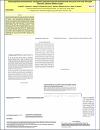Linking depositional environments and diagenetic processes to porosity evolution and destruction in the Arab Formation reservoirs, Offshore oilfields of Qatar
| Author | Sadooni, Fadhil N. |
| Author | Al-Kuwari, Hamad Al-Saad |
| Author | Sakhaee-Pour, Ahmad |
| Author | Matter, Wael S. |
| Available date | 2020-10-22T06:59:12Z |
| Publication Date | 2020 |
| Publication Name | Qatar University Annual Research Forum & Exhibition 2020 |
| Citation | Sadooni F.N., AlKuwari H.A, SakhaeePour A., Matter W.S., "Linking depositional environments and diagenetic processes to porosity evolution and destruction in the Arab Formation reservoirs, Offshore oilfields of Qatar", Qatar University Annual Research Forum and Exhibition (QUARFE 2020), Doha, 2020, https://doi.org/10.29117/quarfe.2020.0043 |
| Abstract | Introduction: The Jurassic Arab Formation is the main oil reservoir in Qatar. The Formation consists of a succession of limestone, dolomite, and anhydrite. Materials and Methods: A multi-proxy approach has been used to study the Formation. This approach is based on core analysis, thin sections, and log data in selected wells in Qatar. Results: The reservoir has been divided into a set of distinctive petrophysical units. The Arab Formation consists of cyclic sediments of oolitic grainstone/packstone, foraminifera-bearing packstone-wackestone, lagoonal mudstone and dolomite, alternating with anhydrite. The sediments underwent a series of diagenetic processes such as leaching, micritization, cementation, dolomitization and fracturing. The impact of these diagenetic processes on the different depositional fabrics created a complex porosity system. So, in some cases there are preserved depositional porosity such as the intergranular porosity in the oolitic grainstone, but in other cases, diagenetic cementation blocked the same pores and eventually destroyed them. In other cases, diagenesis improved the texture of non-porous depositional texture such as mudstone through incipient dolomitization creating inter-crystalline porosity. Dissolution created vugs and void secondary porosity in otherwise non-porous foraminiferal wackestone and packstone. Therefore, creating a matrix of depositional fabrics versus diagenetic processes enabled the identification of different situation in which porosity where either created or destroyed. Future Directions:By correlating the collected petrographic data with logs, it will become possible to identify certain "facio-diagenetic" signatures on logs which will be very useful in both exploration and production. Studying the micro and nano-porosity will provide a better understanding of the evolution and destruction of its porosity system. |
| Language | en |
| Publisher | Qatar University Press |
| Subject | Oil exploration Carbonates Reservoir characterization Qatar. |
| Type | Poster |
Files in this item
This item appears in the following Collection(s)
-
Theme 1: Energy, Environment & Resource Sustainability [108 items ]


